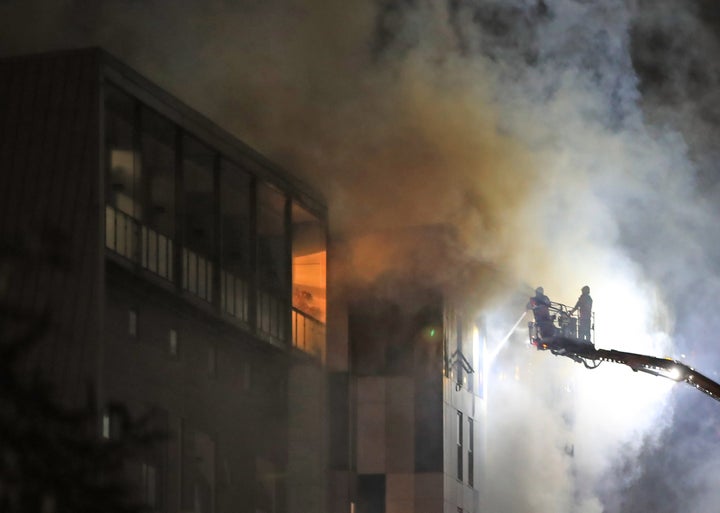A fire at a student accommodation block in Bolton has brought into sharp focus a series of major fire safety concerns that are still unresolved more than two years after the Grenfell disaster.
The Cube building, which housed more than 200 students at the University of Bolton, did not have the same type of cladding that combusted in the Grenfell Tower fire of 2017: instead, it is fitted with high-pressure laminate (HPL) coloured panels.
But questions had been raised over whether this material was fit for high-rise and high-risk buildings even before the blaze in Greater Manchester. Experts had warned a test that deemed HPL “safe” was “flawed” – and said all such buildings should be stripped of the covering.
It is just one of many issues troubling politicians and the industry around the issue of fire safety. The Labour Party has today written to housing secretary Robert Jenrick condemning the government for being “off the pace at every stage since Grenfell”, and warning of a “national crisis and a monumental failure of government regulation”.
Here are some the issues that remain unresolved.
Questions over HPL cladding – and the limits to the ban on combustible material
Cladding on the Bolton student flats was HPL, different from the aluminium composite material – or ACM – fitted at Grenfell and deemed largely “safe”, according to the government.
ACM has been banned and the government has ordered all buildings with the covering to have it removed. But only some types of HPL should be stripped from buildings, ministers said in July, and the Ministry of Housing, Communities and Local Government suggested at the time “no buildings” above 18 metres (six storeys) should have the suspect combinations since they would have failed building regulations.

However, HuffPost UK reported last month that experts think all HPL cladding should be “urgently” removed as they raised major concerns over the laboratory tests of the material – particularly that the BS8414 test does not mirror real world conditions.
HPL is thought to be covering 440 tower blocks that house 26,000 people. Industry sources have told HuffPost UK that dozens of student blocks are HPL-clad.
It’s not just the lack of a ban on HPL that has raised concern. In December last year, combustible materials were banned from all new buildings. But critics fear many types of building have been omitted, including all high-rise hotels and office buildings, and potentially high-risk buildings – including care homes, hospitals and schools – that are below six storeys.
A spokesperson for insulation manufacturer Rockwool, which has made repeated warnings to parliamentary inquiries about fire safety, told HuffPost UK: “This fire has underscored that the 18-metre threshold is not good enough, and that all types of combustible insulation and combustible cladding can pose a risk to public safety, not just ACM cladding.
“The government needs to identify and remove combustible materials on all buildings above 11 metres, and from all high-risk buildings like care homes, schools and hospitals, and ban them on all these buildings going forward.”
Grenfell-style cladding remains on hundreds of buildings
Scores of tower blocks are still covered in Grenfell-style ACM cladding despite ministers pledging £200m to remove the material.
The latest figures show 324 high-rise private and publicly-owned buildings residential still remain ACM-covered, despite the government urging owners to remove the dangerous material and latterly threatening to “name and shame” them.
The problem stems from owners refusing to pick up the cost of removal, often millions of pounds, and often placing the financial burden on leaseholder residents, who have universally said it is too expensive. In any case, the £200m committed by the government – itself a U-turn after initially refusing to help – would not cover the cost of all the removal.
Leaseholders at Citiscape in Croydon, south London, have been facing a £2m bill to have the Grenfell-style cladding removed
Residents have been told by their property management company that the cost of a new cladding system for the 10-storey block is likely to be covered through service charges, which would be borne collectively by leaseholders.
In her letter to the minister, Labour’s shadow housing minister Sarah Jones says it “simply beggars belief” that the the government has left eight in 10 buildings “covered in the same deadly cladding” two-and a-half years after Grenfell. She adds that at the current rate public sector blocks will still be covered in ACM until October 2022, and private blocks until October 2033.
Jones adds of the cash: “Not a single block has been allocated funding, despite the fund being announced six months ago.”
Residents carrying out 24/7 waking watches
People living in ACM-covered buildings are also facing costs and burdens beyond replacing the cladding.
At the Northpoint towerblock in Bromley, south London, tenants are themselves forced to carry out 24-hour fire patrols or “waking watches” to ensure the building does not fall foul of local fire service inspections.
It has meant the annual service charge for a tenant has spiralled from £2,000 to £7,000. HuffPost UK produced a film from the block this summer.
In total, remediation costs are set to reach £70,000 per flat. If they don’t pay, they risk being kicked out for breaching their tenancy.
Campaigner Ritu Saha has told HuffPost UK of the anxiety, illness and financial pain that comes with living in unsellable homes.
She said: “One of my neighbours fell ill with exhaustion and stress after working 12-hour overnight waking watch shifts, after working full-time in the morning.
“Another neighbour is retired, and works from midnight to 7am, three days a week, on the waking watch.
“Another neighbour, who is in the middle of starting his own business, has put his life on hold for over one year to manage the waking watch, and he currently does at least 48 hours a week on the waking watch himself.”
Faulty fire doors on thousands of properties
Issues with fire doors were first identified by the Metropolitan Police in March last year during its investigation of the Grenfell blaze.
It led to products made by five different companies being taken off the market as tests found certain types of “composite” doors – made with glass-reinforced plastic, rather than timber-based – only withstood fire for 15 minutes, which was just half the amount of time they were supposed to last.
A HuffPost UK investigation earlier this year revealed that at least 25,000 faulty fire doors that were planned to be removed as a result of the government edict were still in use.
The situation remains largely in stasis as council bosses warn of a lack of safe products on the market, and are concerned they will not receive compensation despite being sold defective products from the private sector. A remediation plan produced by the fire door industry has also yet to emerge.
In June, Kensington and Chelsea council, the authority responsible for Grenfell, said it had been forced to put back plans to replace all 4,000 fire doors in its entire social housing stock because of a lack of reliable products on the market and a stalemate involving industry and government.
Questions over ‘stay put’ advice
Questions remain over whether the “stay put” policy, which indicates people should not be evacuated from a burning block of flats if the fire mitigation plans are working correctly. Despite major fears over the policy – before Grenfell, six people who died in the Lakanal House, south London, fire in 2009 had all been told to “stay put” – it remains the default setting in local authority guidance, which was written by fire experts and supported across the sector.
But the advice depends on the building behaving in the “correct manner”, as Dany Cotton, the commissioner of the London Fire Brigade, termed it. Grenfell inquiry chair Sir Martin Moore-Bick has said the policy should have been abandoned sooner, and London Fire Brigade has called for the government to carry out an urgent review.
By contrast with Grenfell, the Bolton student accommodation block was evacuated, with Greater Manchester firefighters saying they applied lessons learned from the west London fire when tackling the blaze.
The second part of Moore-Bick’s inquiry, which focuses on building and fire regulations, does not begin until the new year, so a formal government intervention on “stay put” is likely to be many months away.
Other issues
While the government has tested tested HPL and ACM cladding, remaining samples of non-ACM cladding submitted to the government have not been tested to the same standard; sprinklers are a legal requirement for all new high-rise blocks, yet ministers continue to claim retrofitting of high-rise social blocks is “non-essential”; fire risk assessments (FRAs) are not carried out on a habitual basis (and some buildings have never been assessed) and a system of self-regulation means no formal qualifications are needed to carry out FRAs.
